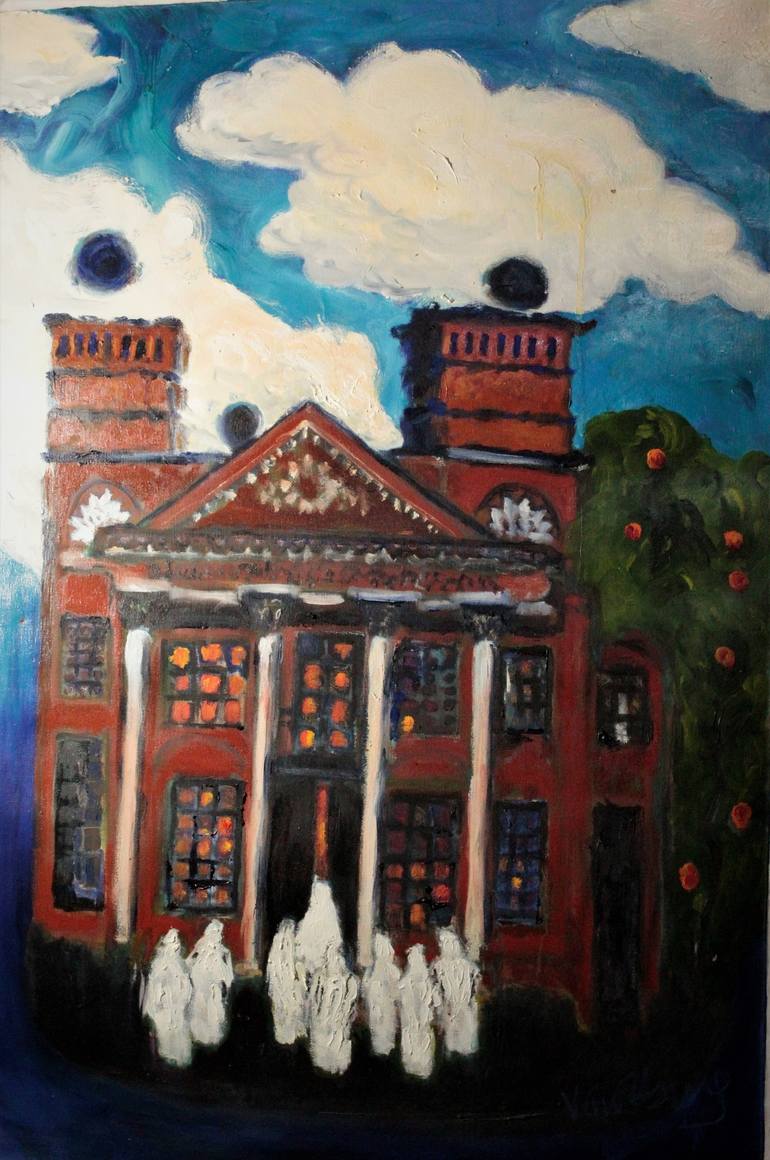


VIEW IN MY ROOM
Choral synagogue "Golden Rose" Yekaterinoslav Painting
United States
Painting, Oil on Canvas
Size: 24 W x 36 H x 0.5 D in
Ships in a Tube
Shipping included
14-day satisfaction guarantee
About The Artwork
The city was founded in 1778 under the name of Novorossiysk. In 1802 the name was changed to Yekaterinoslav. The first Jews began to settle in the area in the second half of the 18th century. In the middle of the 19th century Jewish agricultural settlements began to be established around Yekaterinoslav; they existed until the Nazi occupation.In 1926 the name of the city was changed to Dnepropetrovsk after the prominent Bolshevik Grigiry Petrovskiy.In the late 1920s and 1930s Dnepropetrovsk had several Yiddish schools and a technical college with teaching in Yiddish, as well as a court divison with deliberations in Yiddish. In the 1930s there was also a Yiddish theater in the city. In 1931 Jewish agricultural settlements around Dnepropetrovsk were combined into the Stalindorf Jewish Ethnic County. In the Soviet period the social structure of Dnepropetrovsk Jews changed significantly. During Soviet industrialisation in the late 1920s and 1930s Dnepropetrovsk attracted many new residents due to the establishment there of important industrial, scientific, and cultural centers; the city's total population reached more than half a million. In 1939 Dnepropetrovsk's Jewish populations was 89,529, which amounted to 18 percent of the total population. Many Jews of the city found employment in the new industries.Dnepropetrovsk was occupied by the Germans on August 24, 1941. Most of the Jews succeeded in leaving before the arrival of the German troops. The Jews who remained in Dnepropetrovsk were joined by Jews from the surrounding localities who sought refuge in the big city. Immediately after the beginning of the occupation maltreatment, looting, rapes, and killings of Jews started. Not long afterwards some Germans killed a group of Jews who were praying on Filosofskaya Street. The Jews were ordered to wear white armbands with the Star of David on the sleeves of their clothes. At the end of September or the beginning of October, 1941 Einsatzkommando 5 of Einsatzgruppe C murdered 179 Jews in Dnepropetrovsk. On October 2, 1941 the German authorites required the Jews of Dnepropetrovsk to pay a fine amounting to between twenty-five and thirty million rubles that was to be paid in several installments, the first - on October 12, 1941. In order to collect this amount a special "communal committee," a kind of a Judenrat headed by a lawer named Grinberg, was established. This sum was, in fact, never paid since most of the Jews in Dneprovetrovks were murdered. on October 13-15 (13-14, according to some sources), 1941. At least 10,000 Jews of Dnepropetrovsk were murdered on the southern outskirts of the city. Jews who survived this massacre were murdered, mainly at the end of 1941-beginning of 1942, by various units of Einsatzgruppe C. In February 1942 only 700 Jews remained in the city. They were imprisoned in a labor camp at the Fedoseevskiye barracks and, then, murdered in 1943. According to various sources, a total of about 20,000 Jews were murdered in Dnepropetrovsk during the German occupation. Most of the bodies of the murdered Jews were burned in October 1943 by Sonderkommando 1005, whose purpose was to eliminate the traces of the Nazi crimes. Dnepropetrovsk was liberated by the Soviet Red Army on October 25, 1943.
Details & Dimensions
Painting:Oil on Canvas
Original:One-of-a-kind Artwork
Size:24 W x 36 H x 0.5 D in
Frame:Not Framed
Ready to Hang:Not applicable
Packaging:Ships Rolled in a Tube
Shipping & Returns
Delivery Time:Typically 5-7 business days for domestic shipments, 10-14 business days for international shipments.
Handling:Ships rolled in a tube. Artists are responsible for packaging and adhering to Saatchi Art’s packaging guidelines.
Ships From:United States.
Have additional questions?
Please visit our help section or contact us.
United States
I was born in St.Petersburg, Russia. I enjoyed looking at paintings since I remember myself, was visiting Hermitage, Russian Museum and all other places where I could see something painted in St. Petersburg. During my teenage years I photographed everything that I could, and printed photographs in the makeshift darkroom in the bathroom. I immigrated to Israel in 1979, and was astonished by the strong colors and blinding light of the sun. I could not afford a camera and making photographs the same way I was doing in Russia, but the urge to put everything what I saw on paper was irresistible. I started drawing, thanks to the fact that pencils and papers were cheap enough in Israel. Then I started painting, trying to paint whenever I could. I moved to New York in 1989. My first group show was in 1993; my first solo show was in 1996. At the present time I live in New York City.
Thousands Of Five-Star Reviews
We deliver world-class customer service to all of our art buyers.
Global Selection
Explore an unparalleled artwork selection by artists from around the world.
Satisfaction Guaranteed
Our 14-day satisfaction guarantee allows you to buy with confidence.
Support An Artist With Every Purchase
We pay our artists more on every sale than other galleries.
Need More Help?